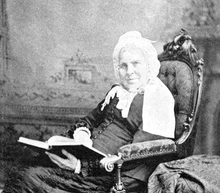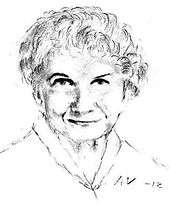Canadian literature
Canadian literature has been created in Canadian English, Canadian French, and Canadian Gaelic, and more recently by First Nations and immigrants of other ancestral backgrounds. Influences on Canadian writers are broad, both geographically and historically, representing Canada's diversity in culture and region.
| Part of a series on the |
| Culture of Canada |
|---|
 |
| History |
| Topics |
| Research |
|
While mostly written in English, "Indigenous literature" has begun to flourish and is based upon many distinct oral traditions, languages, and cultural practices. However, Canadians have been less willing to acknowledge the diverse languages of Canada, such as Canadian Gaelic.[1][2]
| History of modern literature | |||||||||
|---|---|---|---|---|---|---|---|---|---|
| By decade | |||||||||
| Early modern by century | |||||||||
| Mid-modern by century | |||||||||
| 20th–21st century | |||||||||
|
|||||||||
| By region | |||||||||
|
|||||||||
| Related topics | |||||||||
|
|||||||||
|
| |||||||||
The dominant European cultures were originally English, French, and Gaelic. However, in recent decades Canada's literature has been strongly influenced by immigrants from other countries. Since the 1980s Canada's ethnic and cultural diversity has been openly reflected in its literature, with many of its most prominent writers focusing on ethnic minority identity, duality and cultural differences.
Indigenous literature
Indigenous peoples of Canada are culturally diverse.[3] Each group has its own literature, language and culture.[4][3] The term "Indigenous literature" therefore can be misleading. As writer Jeannette Armstrong states in one interview, "I would stay away from the idea of "Native" literature, there is no such thing. There is Mohawk literature, there is Okanagan literature, but there is no generic Native in Canada".[3]
French-Canadian literature
In 1802, the Lower Canada legislative library was founded, being one of the first in Occident, the first in the Canadas. For comparison, the library of the British House of Commons was founded sixteen years later. The library had some rare titles about geography, natural science and letters. All books it contained were moved to the Canadian parliament in Montreal when the two Canadas, lower and upper, were united. On April 25, 1849, a dramatic event occurred: the Canadian parliament was burned by furious people along with thousands of French Canadian books and a few hundred of English books. This is why some people still affirm today, falsely, that from the early settlements until the 1820s, Quebec had virtually no literature. Though historians, journalists, and learned priests published, overall the total output that remain from this period and that had been kept out of the burned parliament is small.
It was the rise of Quebec patriotism and the 1837 Lower Canada Rebellion, in addition to a modern system of primary school education, which led to the rise of French-Canadian fiction. L'influence d'un livre by Philippe-Ignace-Francois Aubert de Gaspé is widely regarded as the first French-Canadian novel. The genres which first became popular were the rural novel and the historical novel. French authors were influential, especially authors like Balzac.

In 1866, Father Henri-Raymond Casgrain became one of Quebec's first literary theorists. He argued that literature's goal should be to project an image of proper Catholic morality. However, a few authors like Louis-Honoré Fréchette and Arthur Buies broke the conventions to write more interesting works.
This pattern continued until the 1930s with a new group of authors educated at the Université Laval and the Université de Montréal. Novels with psychological and sociological foundations became the norm. Gabrielle Roy and Anne Hébert even began to earn international acclaim, which had not happened to French-Canadian literature before. During this period, Quebec theatre, which had previously been melodramas and comedies, became far more involved.
French-Canadian literature began to greatly expand with the turmoil of the Second World War, the beginnings of industrialization in the 1950s, and most especially the Quiet Revolution in the 1960s. French-Canadian literature also began to attract a great deal of attention globally, with Acadian novelist Antonine Maillet winning the Prix Goncourt. An experimental branch of Québécois literature also developed; for instance the poet Nicole Brossard wrote in a formalist style. In 1979, Roch Carrier wrote the story The Hockey Sweater, which highlighted the cultural and social tensions between English and French speaking Canada.
Before Confederation


Because Canada only officially became a country on July 1, 1867, it has been argued that literature written before this time was colonial. For example, Susanna Moodie and Catharine Parr Traill, English sisters who adopted the country as their own, moved to Upper Canada in 1832. They recorded their experiences as pioneers in Parr Traill's The Backwoods of Canada (1836) and Canadian Crusoes (1852), and Moodie's Roughing It in the Bush (1852) and Life in the Clearings (1853). However, both women wrote until their deaths, placing them in the country for more than 50 years and certainly well past Confederation. Moreover, their books often dealt with survival and the rugged Canadian environment; these themes re-appear in other Canadian works, including Margaret Atwood's Survival. Moodie and Parr Traill's sister, Agnes Strickland, remained in England and wrote elegant royal biographies, creating a stark contrast between Canadian and English literatures.
However, one of the earliest "Canadian" writers virtually always included in Canadian literary anthologies is Thomas Chandler Haliburton (1796–1865), who died just two years before Canada's official birth. He is remembered for his comic character, Sam Slick, who appeared in The Clockmaker and other humorous works throughout Haliburton's life.
After 1867

A group of poets now known as the "Confederation Poets", including Charles G. D. Roberts, Archibald Lampman, Bliss Carman, Duncan Campbell Scott, and William Wilfred Campbell, came to prominence in the 1880s and 1890s. Choosing the world of nature as their inspiration, their work was drawn from their own experiences and, at its best, written in their own tones. Isabella Valancy Crawford, Frederick George Scott, and Francis Sherman are also sometimes associated with this group.
During this period, E. Pauline Johnson and William Henry Drummond were writing popular poetry - Johnson's based on her part-Mohawk heritage, and Drummond, the Poet of the Habitant, writing dialect verse.
The L. M. Montgomery novel Anne of Green Gables was first published in 1908. It has sold an estimated 50 million copies and is one of the best selling books worldwide.[5]
Reacting against a tradition that emphasised the wilderness, poet Leonard Cohen's novel Beautiful Losers (1966), was labelled by one reviewer "the most revolting book ever written in Canada".[6] However, Cohen is perhaps best known as a folk singer and songwriter, with an international following.
Canadian author Farley Mowat is best known for his work Never Cry Wolf (1963) and his Governor General's Award-winning children's book, Lost in the Barrens (1956).
Following World War II, writers such as Mavis Gallant, Mordecai Richler, Norman Levine, Margaret Laurence and Irving Layton added to the Modernist influence to Canadian literature previously introduced by F. R. Scott, A. J. M. Smith and others associated with the McGill Fortnightly. This influence, at first, was not broadly appreciated. Norman Levine's Canada Made Me,[7] a travelogue that presented a sour interpretation of the country in 1958, for example, was widely rejected.
After 1967, the country's centennial year, the national government increased funding to publishers and numerous small presses began operating throughout the country.[8] The best-known Canadian children's writers include L. M. Montgomery and Monica Hughes.
Contemporary Canadian literature: After 1967
Arguably, the best-known living Canadian writer internationally (especially since the deaths of Robertson Davies and Mordecai Richler) is Margaret Atwood, a prolific novelist, poet, and literary critic. Some great 20th-century Canadian authors include Margaret Laurence, and Gabrielle Roy.

This group, along with Nobel Laureate Alice Munro, who has been called the best living writer of short stories in English,[9] were the first to elevate Canadian Literature to the world stage. During the post-war decades only a handful of books of any literary merit were published each year in Canada, and Canadian literature was viewed as an appendage to British and American writing. When academic Clara Thomas decided in the 1940s to concentrate on Canadian literature for her master's thesis, the idea was so novel and so radical that word of her decision reached The Globe and Mail books editor William Arthur Deacon, who then personally reached out to Thomas to pledge his and the newspaper's resources in support of her work.[10]
Other major Canadian novelists include Carol Shields, Lawrence Hill, and Alice Munro. Carol Shields novel The Stone Diaries won the 1995 Pulitzer Prize for Fiction, and another novel, Larry's Party, won the Orange Prize in 1998. Lawrence Hill's Book of Negroes won the 2008 Commonwealth Writers' Prize Overall Best Book Award, while Alice Munro became the first Canadian to win the Nobel Prize in Literature in 2013.[11] Munro also received the Man Booker International Prize in 2009.
In the 1960s, a renewed sense of nation helped foster new voices in Canadian poetry, including: Margaret Atwood, Michael Ondaatje, Leonard Cohen, Eli Mandel and Margaret Avison. Others such as Al Purdy, Milton Acorn, and Earle Birney, already published, produced some of their best work during this period.
The TISH Poetry movement in Vancouver brought about poetic innovation from Jamie Reid, George Bowering, Fred Wah, Frank Davey, Daphne Marlatt, David Cull, and Lionel Kearns.
.jpg)
Canadian poets has been expanding the boundaries of originality: Christian Bök, Ken Babstock, Karen Solie, Lynn Crosbie, Patrick Lane, George Elliott Clarke and Barry Dempster have all imprinted their unique consciousnesses onto the map of Canadian imagery.
A notable anthology of Canadian poetry is The New Oxford book of Canadian Verse, edited by Margaret Atwood (ISBN 0-19-540450-5).
Anne Carson is probably the best known Canadian poet living today. Carson in 1996 won the Lannan Literary Award for poetry. The foundation's awards in 2006 for poetry, fiction and nonfiction each came with $US 150,000.
Canadian authors who have won international awards
- Alice Munro (2013)
Man Booker International Prize
- Alice Munro (2009)
Man Booker Prize
- Michael Ondaatje, The English Patient (1992)
- Margaret Atwood, The Blind Assassin (2000)
- Yann Martel, Life of Pi (2002)
- Margaret Atwood, The Testaments (2019)
- Carol Shields, The Stone Diaries (1995)
National Book Critics Circle Award
- Carol Shields, The Stone Diaries (1994)
International Dublin Literary Award
- Alistair MacLeod, No Great Mischief (2001)
- Rawi Hage, De Niro's Game (2008)
Orange Prize
- Anne Michaels, Fugitive Pieces (1997)
- Carol Shields, Larry's Party (1998)
Commonwealth Writers' Prize
- Olive Senior, Summer Lightning (1987)
- Mordecai Richler, Solomon Gursky Was Here (1990)
- Rohinton Mistry, Such a Long Journey (1991)
- Rohinton Mistry, A Fine Balance (1996)
- Austin Clarke, The Polished Hoe (2003)
- Lawrence Hill, The Book of Negroes (2008)
Peace Prize of the German Book Trade
- Margaret Atwood (2017)
Awards
There are a number of notable Canadian awards for literature:
- The Atlantic Writers Competition highlights talent across the Atlantic Provinces.
- Books in Canada First Novel Award for the best first novel of the year
- Canadian Authors Association Awards for Adult Literature, honouring works by Canadian writers that achieve excellence without sacrificing popular appeal since 1975[12]
- CBC Literary Awards
- Canada Council Molson Prize for distinguished contributions to Canada's cultural and intellectual heritage
- Danuta Gleed Literary Award for a first collection of short fiction by a Canadian author writing in English
- Dayne Ogilvie Prize for an emerging writer in the lesbian, gay, bisexual or transgender communities
- Doug Wright Awards for graphic literature and novels
- Floyd S. Chalmers Canadian Play Awards for best Canadian play staged by a Canadian theatre company
- Hilary Weston Writers' Trust Prize for Nonfiction for best work of nonfiction
- Gerald Lampert Award for the best new poet
- Lane Anderson Award for best Canadian non-fiction science
- Giller Prize for the best Canadian novel or book of short stories in English
- Governor General's Awards for the best Canadian fiction, poetry, non-fiction, drama, and translation, in both English and French
- Griffin Poetry Prize for the best book of poetry, one award each for a Canadian poet and an international poet
- Indigenous Voices Awards for works of literature by First Nations, Métis and Inuit writers
- Marian Engel Award for female writers in mid-career
- Matt Cohen Award to honour a Canadian writer for a lifetime of distinguished achievement
- Milton Acorn Poetry Awards for an outstanding "people's poet"
- National Business Book Award
- Pat Lowther Award for poetry written by a woman
- Prix Aurora Awards for Canadian science fiction and fantasy, in English and French
- RBC Bronwen Wallace Award for Emerging Writers
- Rogers Writers' Trust Fiction Prize for the best work of fiction
- Shaughnessy Cohen Award for Political Writing
- Stephen Leacock Award For Humour
- W.O. Mitchell Literary Prize for a writer who has made a distinguished lifetime contribution both to Canadian literature and to mentoring new writers
- Room of One's Own Annual Award for poetry and literature
- 3-Day Novel Contest annual literary marathon, born in Canada
- Writers' Trust Engel/Findley Award for a distinguished writer in mid-career
- Writers' Trust / McClelland & Stewart Journey Prize
Awards For Children's and Young Adult Literature:
- Young Adult Novel Prize of the Atlantic Writers Competition
- R.Ross Annett Award for Children's Literature
- Geoffrey Bilson Award for Historical Fiction
- Ann Connor Brimer Award
- Canadian Library Association Book of the Year Award for Children
- CLA Young Adult Canadian Book Award
- Sheila A. Egoff Children's Literature Prize
- Elizabeth Mrazik-Cleaver Canadian Picture Book Award
- Floyd S. Chalmers Award for Theatre for Young Adults
- Amelia Frances Howard-Gibbon Illustrator's Award
- Information Book of the Year
- I0DE Book Award
- Max and Greta Ebel Memorial Award for Children's Writing
- Norma Fleck Award for children's non-fiction
- Governor-General's Awards for the best Canadian children's literature, text-based or illustrated, in both English and French
- QWF Prize for Children's and Young Adult Literature
- Vicky Metcalf Award for Children's Literature
Further reading
- K. Balachandran, K. (2007) Canadian Literature: An Overview. Sarup & Sons
- Eugene Benson and William Toye, eds. (1997) The Oxford companion to Canadian literature; online. 1226 pp of short articles by experts.
- Faye Hammill (2007). Canadian literature. Edinburgh Univ. Press. ISBN 978-0-7486-2162-0
- Jeffrey M. Heath (1991). Profiles in Canadian Literature, Volume 7. Dundurn Press. ISBN 1-55002-145-1
- William H. New (1990). Native writers and Canadian writing. UBC Press. ISBN 0-7748-0370-3
- William H. New (2002). Encyclopedia of literature in Canada. Univ. Toronto Press. ISBN 0-8020-0761-9
- William H. New (2003). A history of Canadian literature. McGill-Queen's Univ. Press. ISBN 0-7735-2597-1
- Michael Newton (2015) Seanchaidh na Coille / The Memory-Keeper of the Forest: Anthology of Scottish-Gaelic Literature of Canada.
- Reingard M. Nischik (2008). History of literature in Canada: English-Canadian and French-Canadian. Camden House. ISBN 9781571133595
- Pivato, Joseph (1994 and 2003). Echo: Essays on Other Literatures. Guernica Editions. ISBN 1-55071-176-8
- David Stouck (1988). Major Canadian authors: a critical introduction to Canadian literature in English. Univ. Nebraska Press. ISBN 0-8032-4119-4
- Cynthia Sugars and Eleanor Ty, eds. (2015). Canadian Literature and Cultural Memory. Oxford Univ. Press, 493pp. Scholarly essays on how cultural memory is reflected in Canadian fiction, poetry, drama, films, etc.
- Elizabeth Waterston (1973). Survey; a short history of Canadian literature. Methuen. ISBN 0-458-90930-0
See also
- Regional–such as the prairie novel or Quebec theatre.
- By author: Canadian women; Acadians, Aboriginal peoples in Canada; Irish Canadians; Italian-Canadians: South-Asian-Canadian
- Literary period: "The Confederation Poets", "Canadian postmoderns" or "Canadian Poets Between the Wars."
- Canadian poetry
- Canadian science fiction
- List of Canadian writers
- List of Canadian short story writers
- The Canadian Centenary Series
- Canada Reads
- Canadian content
- Theatre of Canada
References
- Newton, Michael (2015). Seanchaidh na Coille / The Memory-Keeper of the Forest. Cape Breton University Press.
- Rankin, Effie. "A shared song lasts long". Comhairle na Gàidhlig. Gaelic Council of Nova Scotia. Retrieved 14 January 2017.
- Eigenbrod, Renate; et al. (2003). "Aboriginal Literatures in Canada: A Teacher's Resource Guide A Teacher's Resource Guide" (PDF). Archived from the original (PDF) on 2016-09-10. Retrieved 2019-11-05.
- "Culture". indigenousfoundations.adm.arts.ubc.ca. Archived from the original on 2017-03-24. Retrieved 2017-03-21.
- Reuters Archived 2010-01-13 at the Wayback Machine on Anne of Green Gables: ""Anne of Green Gables" has sold more than 50 million copies and been translated into 20 languages, according to Penguin." (19 March 2008)
- Who held a gun to Leonard Cohen's head? Tim de Lisle, Guardian Online, retrieved 11 October 2006.
- "Norman Levine". Independent.co.uk. 20 June 2005. Retrieved 2017-08-20.
- "Small Presses in the 1960s and 1970s". The Canadian Encyclopedia. Archived from the original on 2009-03-04. Retrieved 2008-01-26.
- "For a long time Alice Munro has been compared with Chekhov; John Updike would add Tolstoy, and AS Byatt would say Guy de Maupassant and Flaubert. Munro is often called the best living writer of short stories in English; the words "short story" are frequently dropped." Riches of a Double Life, Ada Edemariam, Guardian Online, retrieved 11 October 2006.
- "Author and educator Clara Thomas was a relentless advocate of CanLit". The Globe and Mail, November 28, 2013.
- "Nobel-winner Alice Munro hailed as 'master' of short stories". Cbc.ca. Retrieved 2017-08-20.
- "Canadian Authors Association Literary Awards". Canadian Authors. Archived from the original on 2014-04-25. Retrieved 2014-04-24.
External links
- Introduction - Canadian Writers - Library and Archives Canada
- Canadian Literature - CanLit
- Canadian Literature - Historica - The Canadian Encyclopedia Library
- Canadian Writers - Resource for Canadian authors publishing in English or French - Athabasca University, Alberta
- Studies in Canadian Literature / Études en littérature canadienne - University of New Brunswick
- Dominion of the North: Literary & Print Culture in Canada - An online exhibition celebrating prominent poets, authors, and historians. It comprises one hundred monographs, organized topically into eight collections.